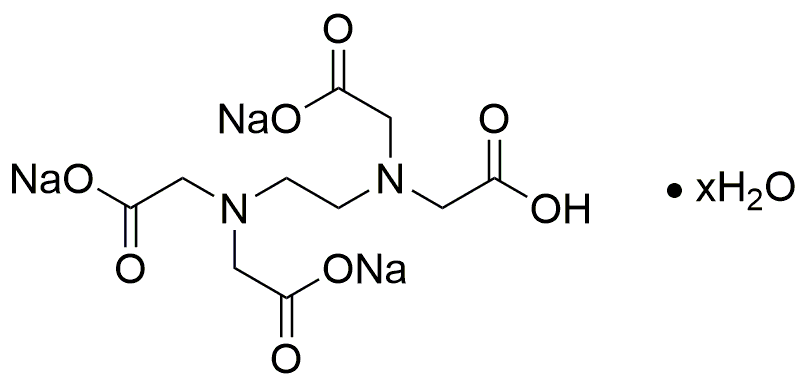Ethylenediaminetetraacetic acid trisodium salt hydrate is widely utilized in research focused on:
- Water Treatment: This compound effectively chelates metal ions, making it valuable in water purification processes by removing harmful heavy metals.
- Food Preservation: It is commonly used as a food additive to prevent discoloration and spoilage by binding metal ions that can catalyze oxidation.
- Medical Applications: In medicine, it serves as a chelating agent for treating heavy metal poisoning, such as lead and mercury, by facilitating their excretion from the body.
- Laboratory Reagents: Researchers use it in biochemical assays and experiments to stabilize enzymes and proteins by preventing metal ion interference.
- Agriculture: It is applied in fertilizers to enhance nutrient availability by chelating essential trace elements, promoting better plant growth.
General Information
Properties
Safety and Regulations
Applications
Ethylenediaminetetraacetic acid trisodium salt hydrate is widely utilized in research focused on:
- Water Treatment: This compound effectively chelates metal ions, making it valuable in water purification processes by removing harmful heavy metals.
- Food Preservation: It is commonly used as a food additive to prevent discoloration and spoilage by binding metal ions that can catalyze oxidation.
- Medical Applications: In medicine, it serves as a chelating agent for treating heavy metal poisoning, such as lead and mercury, by facilitating their excretion from the body.
- Laboratory Reagents: Researchers use it in biochemical assays and experiments to stabilize enzymes and proteins by preventing metal ion interference.
- Agriculture: It is applied in fertilizers to enhance nutrient availability by chelating essential trace elements, promoting better plant growth.
Documents
Safety Data Sheets (SDS)
The SDS provides comprehensive safety information on handling, storage, and disposal of the product.
Product Specification (PS)
The PS provides a comprehensive breakdown of the product’s properties, including chemical composition, physical state, purity, and storage requirements. It also details acceptable quality ranges and the product's intended applications.
Certificates of Analysis (COA)
Search for Certificates of Analysis (COA) by entering the products Lot Number. Lot and Batch Numbers can be found on a product’s label following the words ‘Lot’ or ‘Batch’.
*Catalog Number
*Lot Number
Certificates Of Origin (COO)
This COO confirms the country where the product was manufactured, and also details the materials and components used in it and whether it is derived from natural, synthetic, or other specific sources. This certificate may be required for customs, trade, and regulatory compliance.
*Catalog Number
*Lot Number
Safety Data Sheets (SDS)
The SDS provides comprehensive safety information on handling, storage, and disposal of the product.
DownloadProduct Specification (PS)
The PS provides a comprehensive breakdown of the product’s properties, including chemical composition, physical state, purity, and storage requirements. It also details acceptable quality ranges and the product's intended applications.
DownloadCertificates of Analysis (COA)
Search for Certificates of Analysis (COA) by entering the products Lot Number. Lot and Batch Numbers can be found on a product’s label following the words ‘Lot’ or ‘Batch’.
*Catalog Number
*Lot Number
Certificates Of Origin (COO)
This COO confirms the country where the product was manufactured, and also details the materials and components used in it and whether it is derived from natural, synthetic, or other specific sources. This certificate may be required for customs, trade, and regulatory compliance.


